harles
Kuja ERP - Web App for Back Office and Admins.
Project summary:
The Kuja Ecosystem is one of the top digital products of ABinBev in Africa. Kuja serves over 5 countries in Africa and is still expanding its reach. The goal of Kuja is to provide sellers (POCs and Bulk-breakers) and buyers (Retailers) platforms to buy and sell ABI products and manage their businesses all in one place. Different Kuja platforms perform different functions and serves some specific users.ERP web app streamlines back-office operations and administrative tasks, enhancing efficiency and productivity. For Kuja ERP, I worked as a support designer - working on some core elements used for the web app including: table build components, buttons, side menu bar and a couple of others. I also worked on a few features like
Role
Snr. Product Designer
Company
ABinBev
Industry
Beverage
Net Worth
$110 billion (2025)
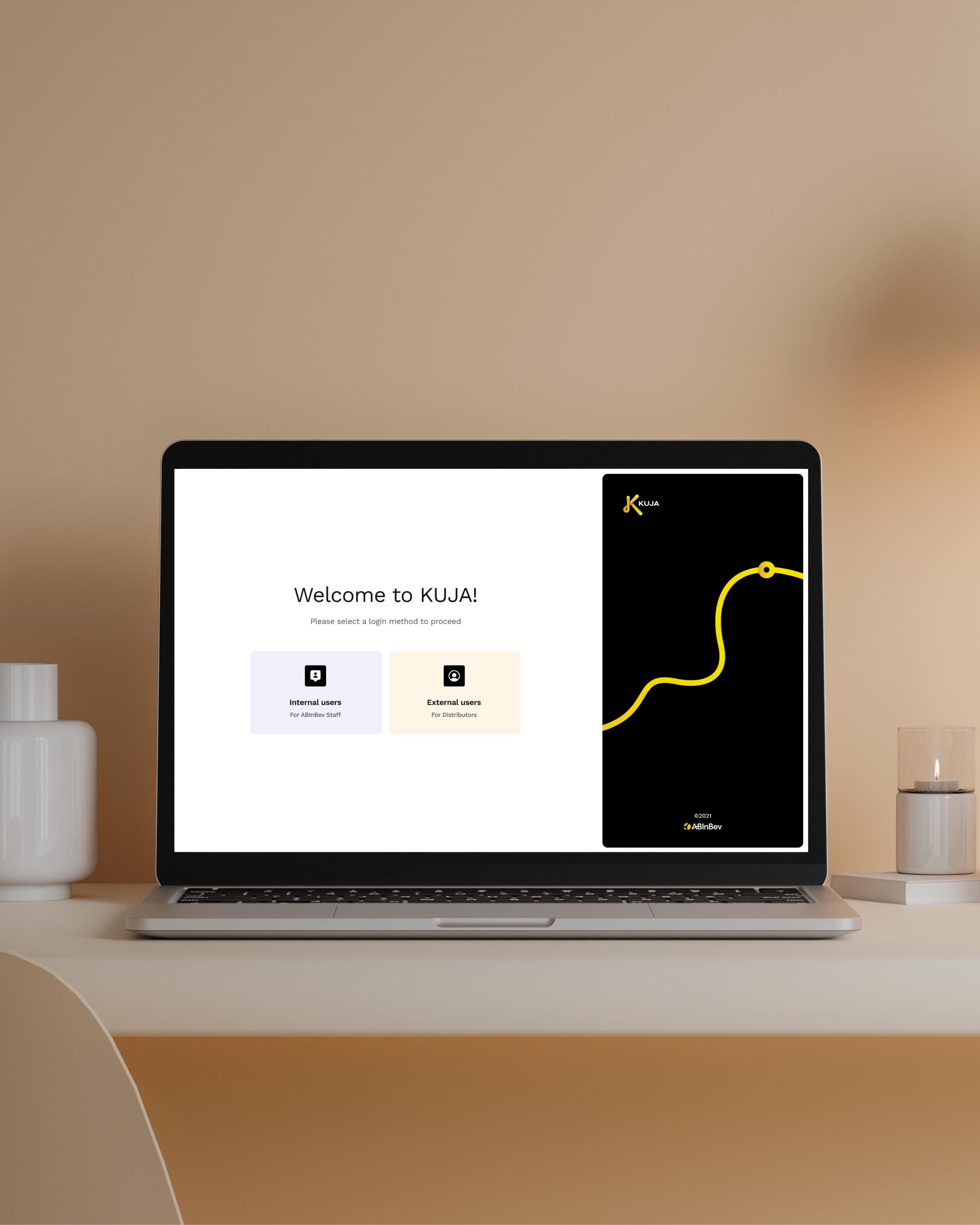
Stage 1. Market research and analysis
- Initiated the project by reviewing existing ERP systems within AB InBev’s African market footprint, identifying usability gaps and inconsistencies across platforms.
- Analyzed how point-of-contact (POC) sellers, bulk-breakers, and back-office administrators interact with the ERP, highlighting opportunities to improve navigation, efficiency, and data management.
Stage 2. Concept development and user flow design
- Collaborated with product managers and my team designers to conceptualize improvements for key ERP modules.
- Prioritized simplicity, speed, and consistency across all touchpoints to reduce learning curves for users across multiple African countries.
Stage 3. Component elements design
- Created detailed wireframes for reusable UI components such as tables, buttons, and side menu navigation, ensuring a consistent design system.
- Integrated accessibility principles (contrast, font size, state indicators) to make the platform inclusive for a diverse user base.
Kuja web app UI design
- The Kuja ERP is the core of the Kuja ecosystem which we designed for two primary users: Back office and Admin users. Both users experience the web app slightly differently. The ERP manages Kuja in different countries in Africa including: Nigeria, Ghana, Zambia, Mozambique, South Africa, Uganda, and Tanzania.For the Kuja ERP web app, I contributed as a support designer, focusing on building core UI components such as tables, buttons, and the side navigation menu. I also collaborated on the design of several key features that enhanced functionality and improved the overall user experience.
- Back office - Home pageBack office home page displays vital information: total sales, orders, sales volume etc. Additionally, users can perform some quick actions and get updates.
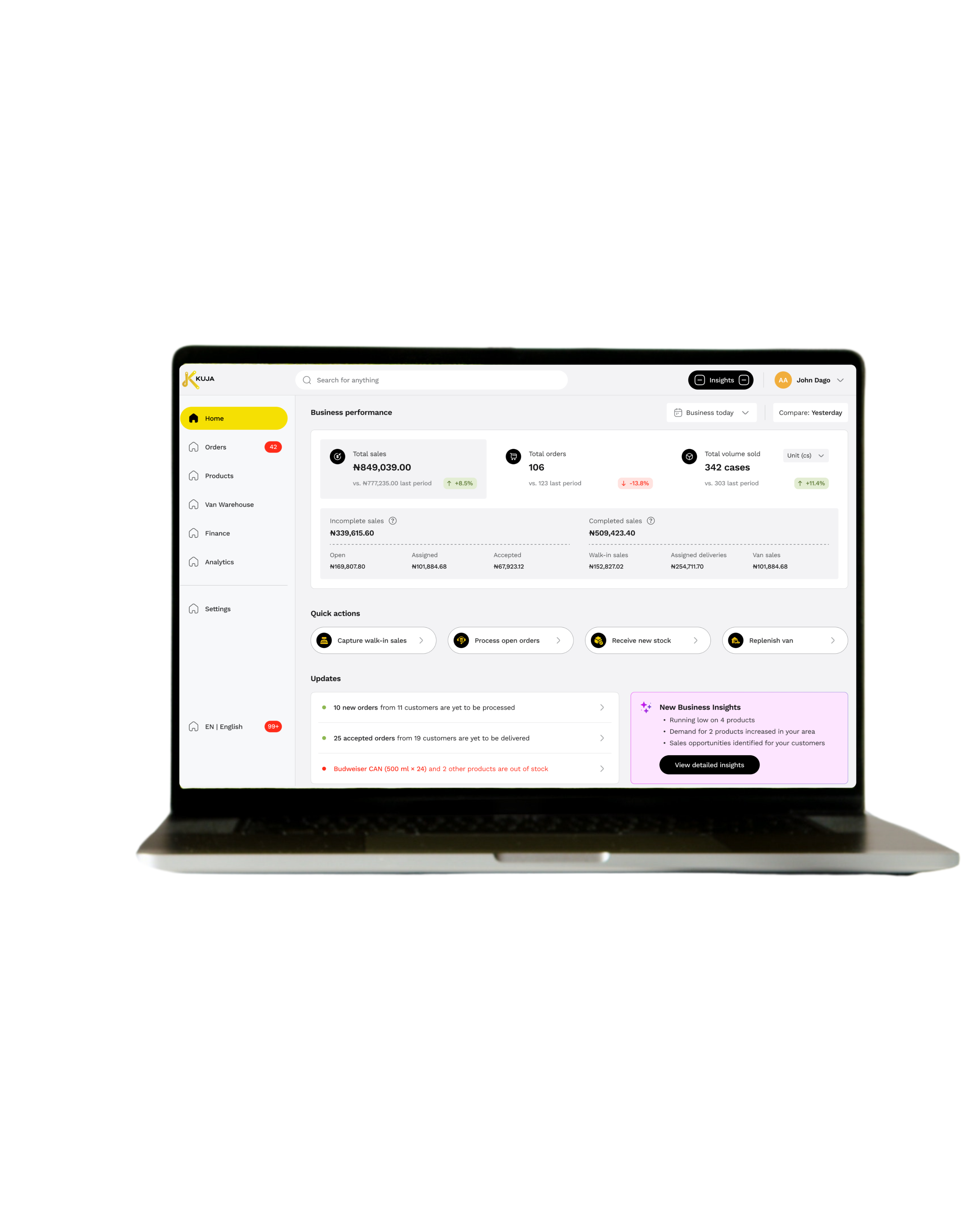
- Back office - FinanceUsers can add new records for sales and also view customer balances. The profit and loss summary is also available for users.
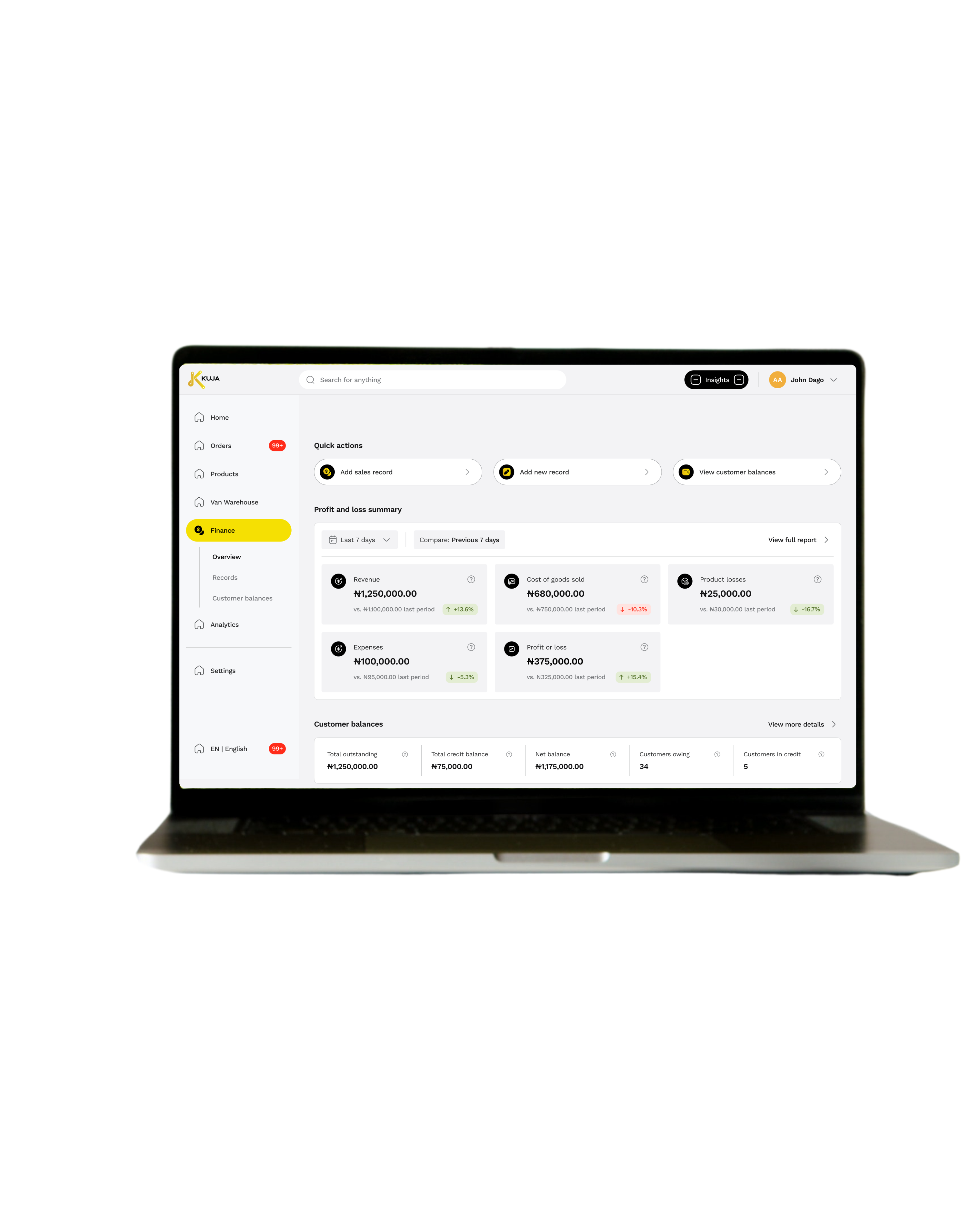
- Back office - ProductsProducts are added in the back office and are available for other users on different Kuja platforms to buy. Product prices are also managed here.
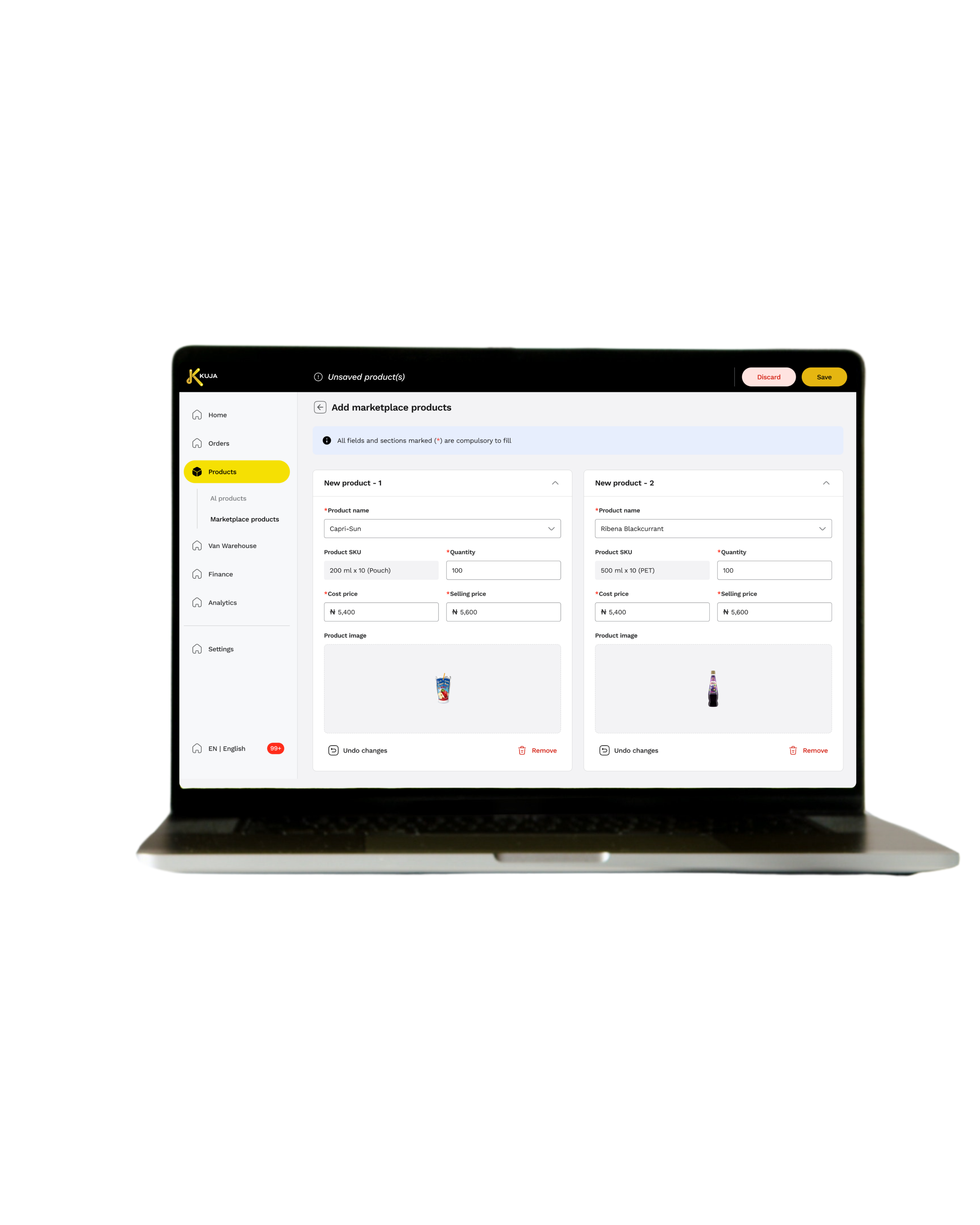
- Back office - AnalyticsAnalytics give a breakdown of sources for revenue, orders, and volume. Users can also filter by time frame and compare results.
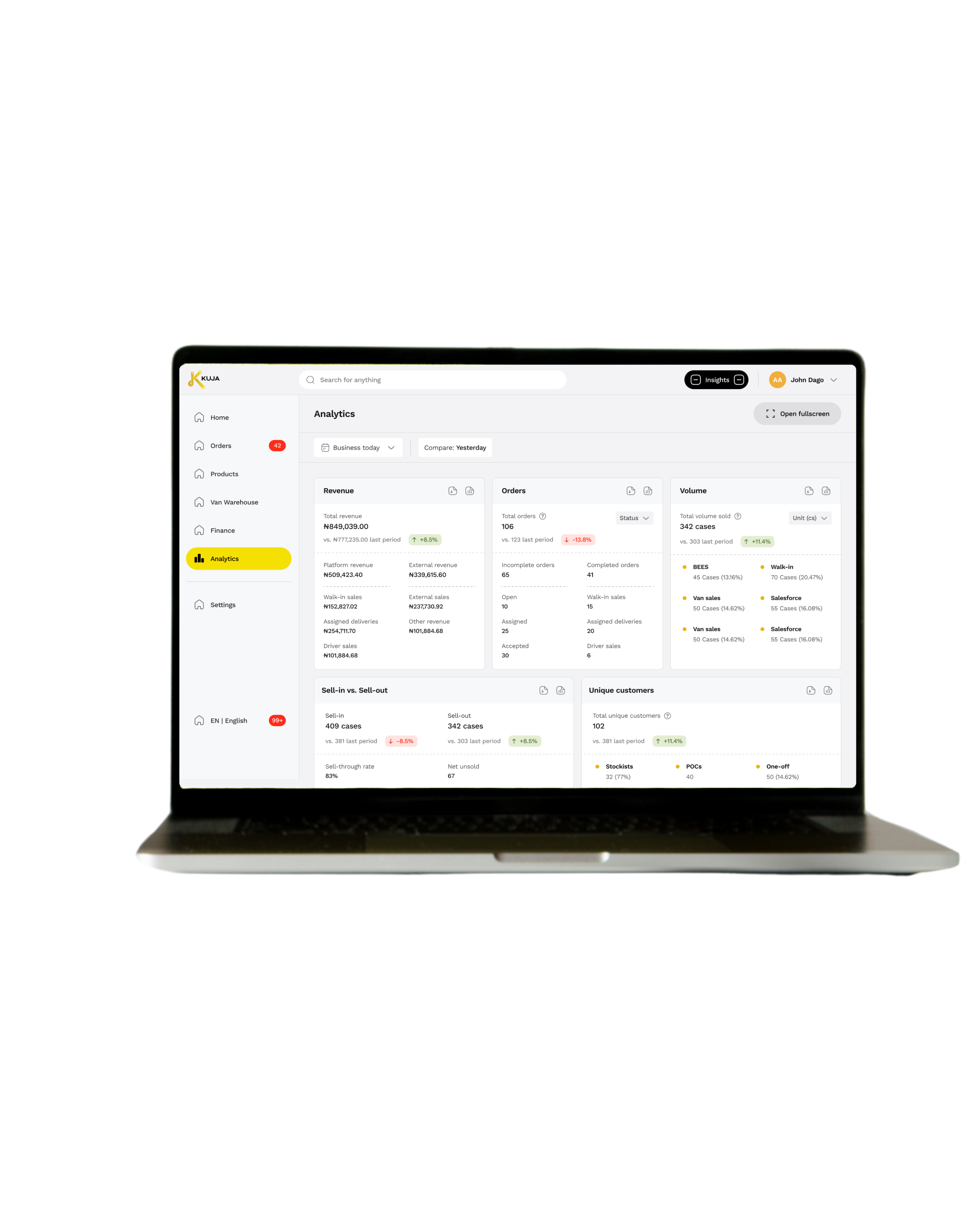
- Admin - HomeAdmins and super admins manage all distributors, users, products, customers for each of the countries.
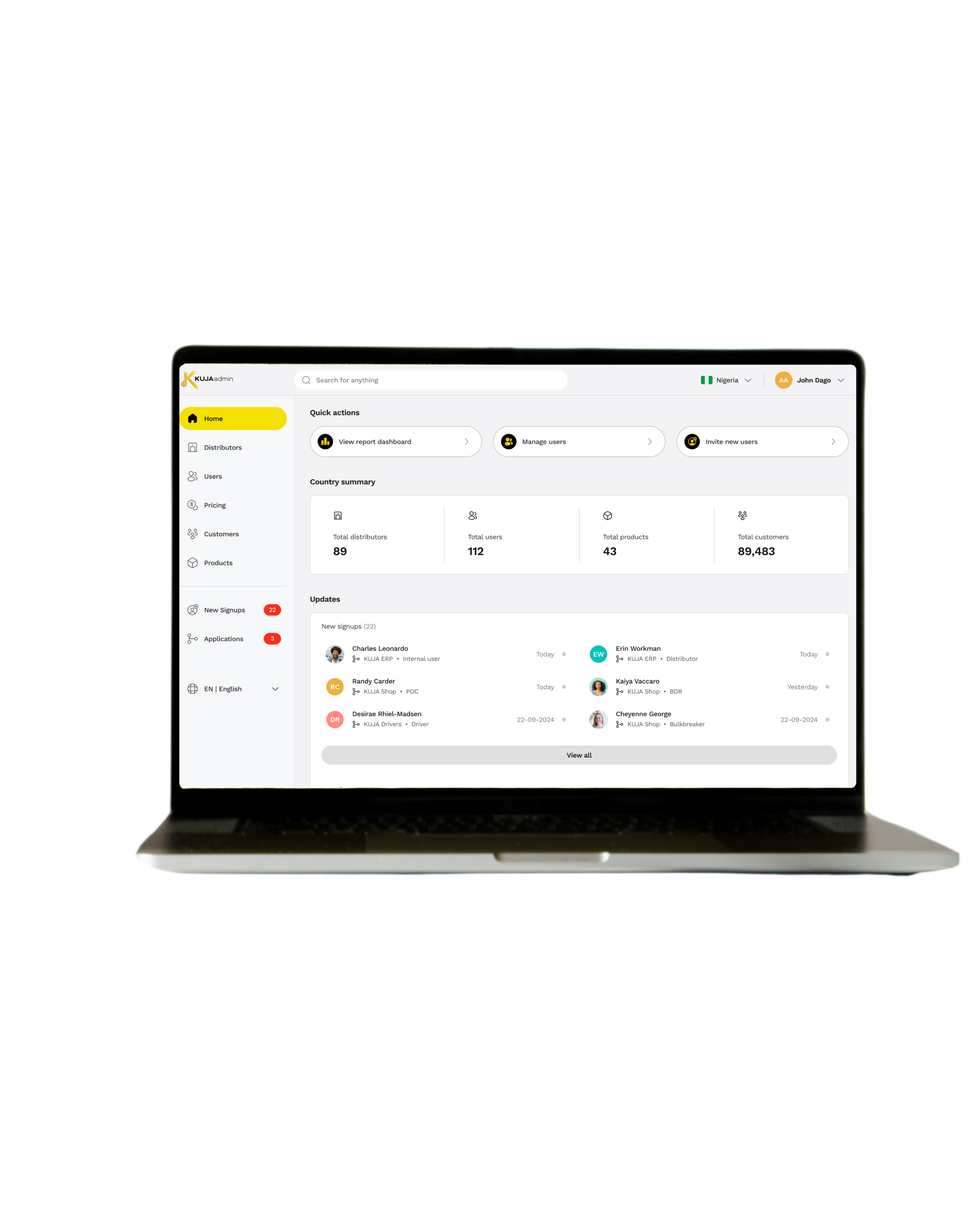
- Admin - DistributorsDistributors page shows the list of distributors in a country. Names, code, state, and status of distributors are displayed. Users can also filter on this screen.
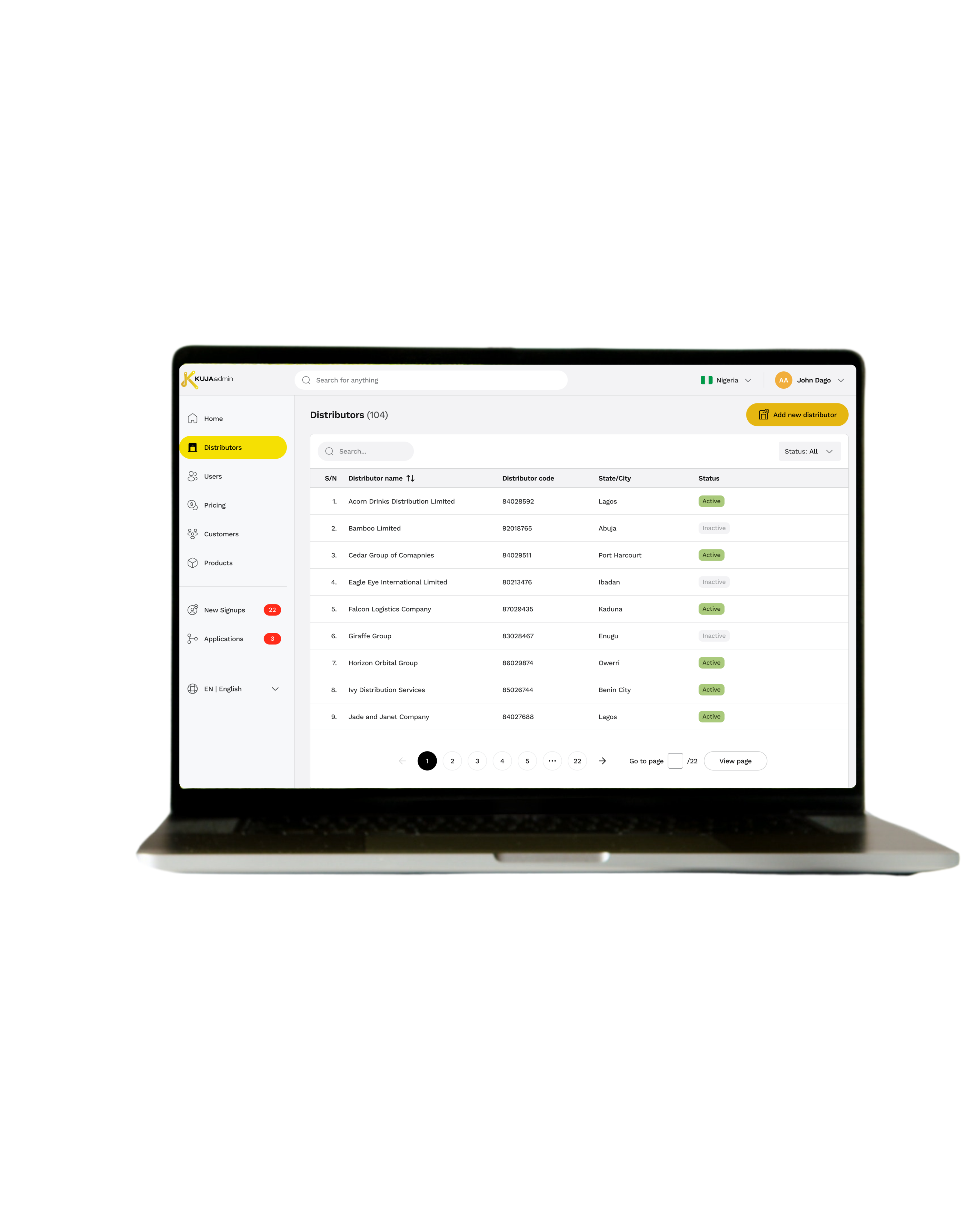
- Admin - New SignupAdmin can see all new users (distributors) that sign up on Kuja. Different user types can also be seen here.
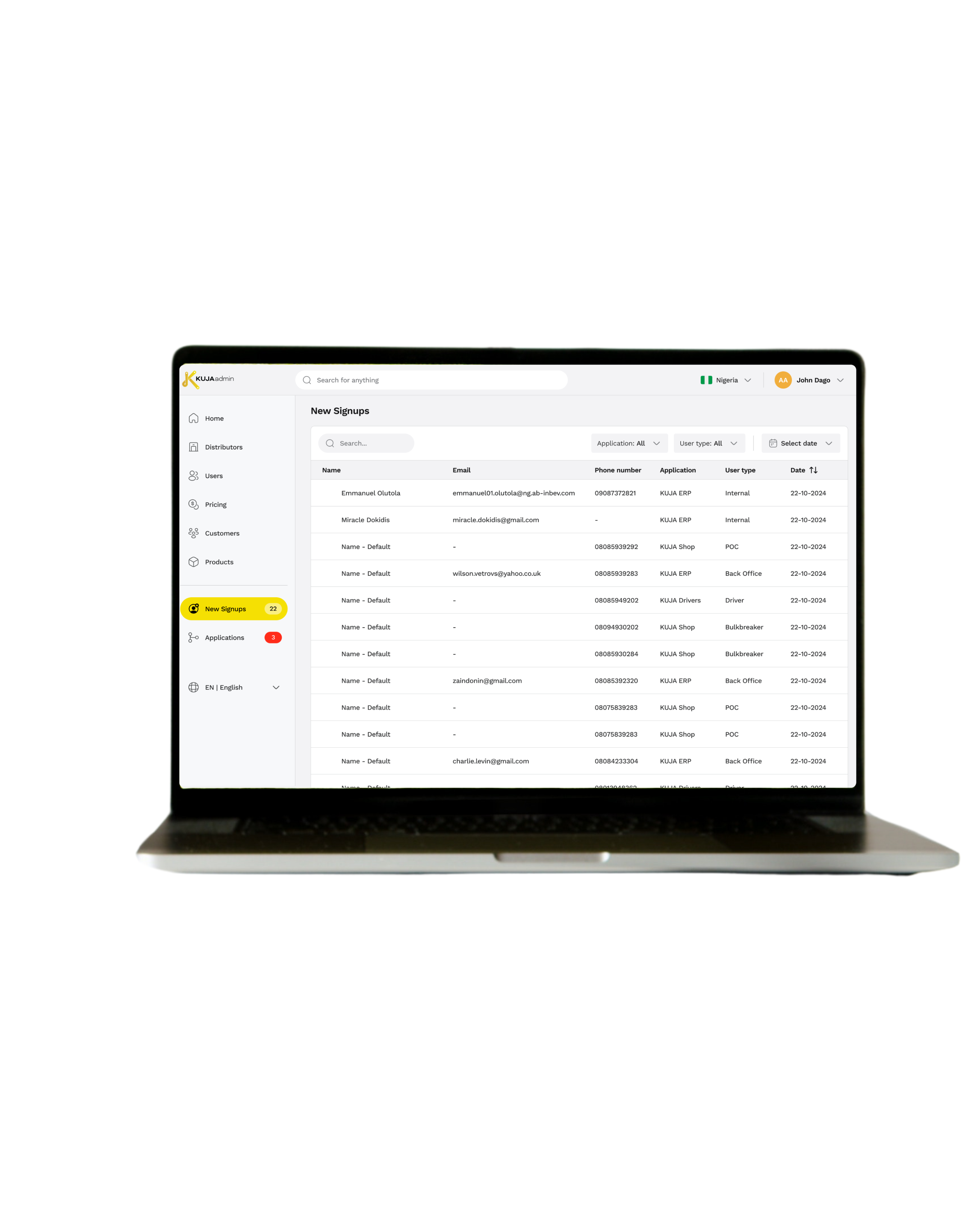
- Admin - ApplicationsAdmins can see any manage all applications on the Kuja ecosystem.
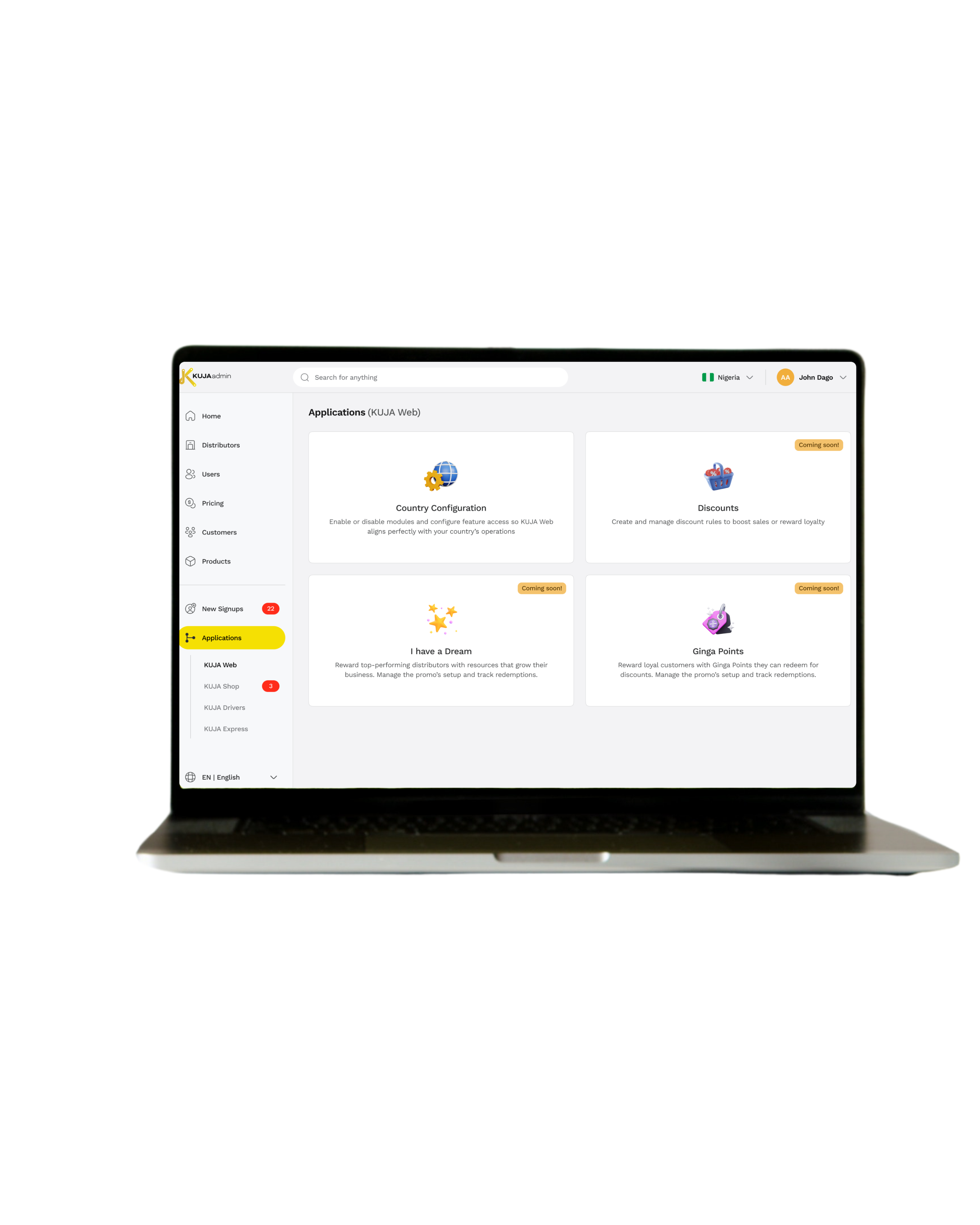
Results
These are some clear, measurable, and actionable results I can attribute to my work on the Kuja ERP web app design as a support designer:
- Improved Operational Efficiency: Reduced developer handoff time by 20% and improved build efficiency for new features.
- Enhanced User Navigation: Cut average task navigation time for back-office staff by 25%, improving daily workflow efficiency.
- Increased Interface Consistency: Decreased UI inconsistencies by 40%, improving user familiarity and reducing training needs.
- Supported Faster Feature Development: Shortened the design-to-development cycle for new ERP features by 15%.

Reflections
Working on the Kuja ERP web app gave me first-hand experience in designing for a high-impact enterprise system used across multiple African markets. As a support designer, I learned how even seemingly small UI components, tables, buttons, navigation bars, can have a massive ripple effect on usability, efficiency, and scalability.Most importantly, this experience deepened my understanding of how design supports operational excellence, especially in ERP products where clarity, efficiency, and reliability are critical to business success.
harles
Copyright 2025 by Charles Nwafor
harles
Kuja ERP - Web App for Back Office and Admins.
Project summary:
The Kuja Ecosystem is one of the top digital products of ABinBev in Africa. Kuja serves over 5 countries in Africa and is still expanding its reach. The goal of Kuja is to provide sellers (POCs and Bulk-breakers) and buyers (Retailers) platforms to buy and sell ABI products and manage their businesses all in one place. Different Kuja platforms perform different functions and serves some specific users.ERP web app streamlines back-office operations and administrative tasks, enhancing efficiency and productivity. For Kuja ERP, I worked as a support designer - working on some core elements used for the web app including: table build components, buttons, side menu bar and a couple of others. I also worked on a few features like
Role
Snr. Product Designer
Company
ABinBev
Industry
Beverage
Net Worth
$110 billion (2025)

Stage 1. Market research and analysis
- Initiated the project by reviewing existing ERP systems within AB InBev’s African market footprint, identifying usability gaps and inconsistencies across platforms.
- Analyzed how point-of-contact (POC) sellers, bulk-breakers, and back-office administrators interact with the ERP, highlighting opportunities to improve navigation, efficiency, and data management.
Stage 2. Concept development and user flow design
- Collaborated with product managers and my team designers to conceptualize improvements for key ERP modules.
- Prioritized simplicity, speed, and consistency across all touchpoints to reduce learning curves for users across multiple African countries.
Stage 3. Component elements design
- Created detailed wireframes for reusable UI components such as tables, buttons, and side menu navigation, ensuring a consistent design system.
- Integrated accessibility principles (contrast, font size, state indicators) to make the platform inclusive for a diverse user base.
Kuja web app UI design
- The Kuja ERP is the core of the Kuja ecosystem which we designed for two primary users: Back office and Admin users. Both users experience the web app slightly differently. The ERP manages Kuja in different countries in Africa including: Nigeria, Ghana, Zambia, Mozambique, South Africa, Uganda, and Tanzania.For the Kuja ERP web app, I contributed as a support designer, focusing on building core UI components such as tables, buttons, and the side navigation menu. I also collaborated on the design of several key features that enhanced functionality and improved the overall user experience.
- Back office - Home pageBack office home page displays vital information: total sales, orders, sales volume etc. Additionally, users can perform some quick actions and get updates.

- Back office - FinanceUsers can add new records for sales and also view customer balances. The profit and loss summary is also available for users.

- Back office - ProductsProducts are added in the back office and are available for other users on different Kuja platforms to buy. Product prices are also managed here.

- Back office - AnalyticsAnalytics give a breakdown of sources for revenue, orders, and volume. Users can also filter by time frame and compare results.

- Admin - HomeAdmins and super admins manage all distributors, users, products, customers for each of the countries.

- Admin - DistributorsDistributors page shows the list of distributors in a country. Names, code, state, and status of distributors are displayed. Users can also filter on this screen.

- Admin - New SignupAdmin can see all new users (distributors) that sign up on Kuja. Different user types can also be seen here.

- Admin - ApplicationsAdmins can see any manage all applications on the Kuja ecosystem.

Results
These are some clear, measurable, and actionable results I can attribute to my work on the Kuja ERP web app design as a support designer:
- Improved Operational Efficiency: Reduced developer handoff time by 20% and improved build efficiency for new features.
- Enhanced User Navigation: Cut average task navigation time for back-office staff by 25%, improving daily workflow efficiency.
- Increased Interface Consistency: Decreased UI inconsistencies by 40%, improving user familiarity and reducing training needs.
- Supported Faster Feature Development: Shortened the design-to-development cycle for new ERP features by 15%.

Reflections
Working on the Kuja ERP web app gave me first-hand experience in designing for a high-impact enterprise system used across multiple African markets. As a support designer, I learned how even seemingly small UI components, tables, buttons, navigation bars, can have a massive ripple effect on usability, efficiency, and scalability.Most importantly, this experience deepened my understanding of how design supports operational excellence, especially in ERP products where clarity, efficiency, and reliability are critical to business success.
harles
Projects
UX process
About
Copyright 2025 by Charles Nwafor
harles
Kuja ERP - Web App for Back Office and Admins.
Project summary:
The Kuja Ecosystem is one of the top digital products of ABinBev in Africa. Kuja serves over 5 countries in Africa and is still expanding its reach. The goal of Kuja is to provide sellers (POCs and Bulk-breakers) and buyers (Retailers) platforms to buy and sell ABI products and manage their businesses all in one place. Different Kuja platforms perform different functions and serves some specific users.ERP web app streamlines back-office operations and administrative tasks, enhancing efficiency and productivity. For Kuja ERP, I worked as a support designer - working on some core elements used for the web app including: table build components, buttons, side menu bar and a couple of others. I also worked on a few features like
Role
Snr. Product Designer
Company
ABinBev
Industry
Beverage
Net Worth
$110 billion (2025)

Stage 1. Market research and analysis
- Initiated the project by reviewing existing ERP systems within AB InBev’s African market footprint, identifying usability gaps and inconsistencies across platforms.
- Analyzed how point-of-contact (POC) sellers, bulk-breakers, and back-office administrators interact with the ERP, highlighting opportunities to improve navigation, efficiency, and data management.
Stage 2. Concept development and user flow design
- Collaborated with product managers and my team designers to conceptualize improvements for key ERP modules.
- Prioritized simplicity, speed, and consistency across all touchpoints to reduce learning curves for users across multiple African countries.
Stage 3. Component elements design
- Created detailed wireframes for reusable UI components such as tables, buttons, and side menu navigation, ensuring a consistent design system.
- Integrated accessibility principles (contrast, font size, state indicators) to make the platform inclusive for a diverse user base.
Kuja web app UI design
- The Kuja ERP is the core of the Kuja ecosystem which we designed for two primary users: Back office and Admin users. Both users experience the web app slightly differently. The ERP manages Kuja in different countries in Africa including: Nigeria, Ghana, Zambia, Mozambique, South Africa, Uganda, and Tanzania.For the Kuja ERP web app, I contributed as a support designer, focusing on building core UI components such as tables, buttons, and the side navigation menu. I also collaborated on the design of several key features that enhanced functionality and improved the overall user experience.
- Back office - Home pageBack office home page displays vital information: total sales, orders, sales volume etc. Additionally, users can perform some quick actions and get updates.

- Back office - FinanceUsers can add new records for sales and also view customer balances. The profit and loss summary is also available for users.

- Back office - ProductsProducts are added in the back office and are available for other users on different Kuja platforms to buy. Product prices are also managed here.

- Back office - AnalyticsAnalytics give a breakdown of sources for revenue, orders, and volume. Users can also filter by time frame and compare results.

- Admin - HomeAdmins and super admins manage all distributors, users, products, customers for each of the countries.

- Admin - DistributorsDistributors page shows the list of distributors in a country. Names, code, state, and status of distributors are displayed. Users can also filter on this screen.

- Admin - New SignupAdmin can see all new users (distributors) that sign up on Kuja. Different user types can also be seen here.

- Admin - ApplicationsAdmins can see any manage all applications on the Kuja ecosystem.

Results
These are some clear, measurable, and actionable results I can attribute to my work on the Kuja ERP web app design as a support designer:
- Improved Operational Efficiency: Reduced developer handoff time by 20% and improved build efficiency for new features.
- Enhanced User Navigation: Cut average task navigation time for back-office staff by 25%, improving daily workflow efficiency.
- Increased Interface Consistency: Decreased UI inconsistencies by 40%, improving user familiarity and reducing training needs.
- Supported Faster Feature Development: Shortened the design-to-development cycle for new ERP features by 15%.

Reflections
Working on the Kuja ERP web app gave me first-hand experience in designing for a high-impact enterprise system used across multiple African markets. As a support designer, I learned how even seemingly small UI components, tables, buttons, navigation bars can have a massive ripple effect on usability, efficiency, and scalability.Most importantly, this experience deepened my understanding of how design supports operational excellence, especially in ERP products where clarity, efficiency, and reliability are critical to business success.
Other projects
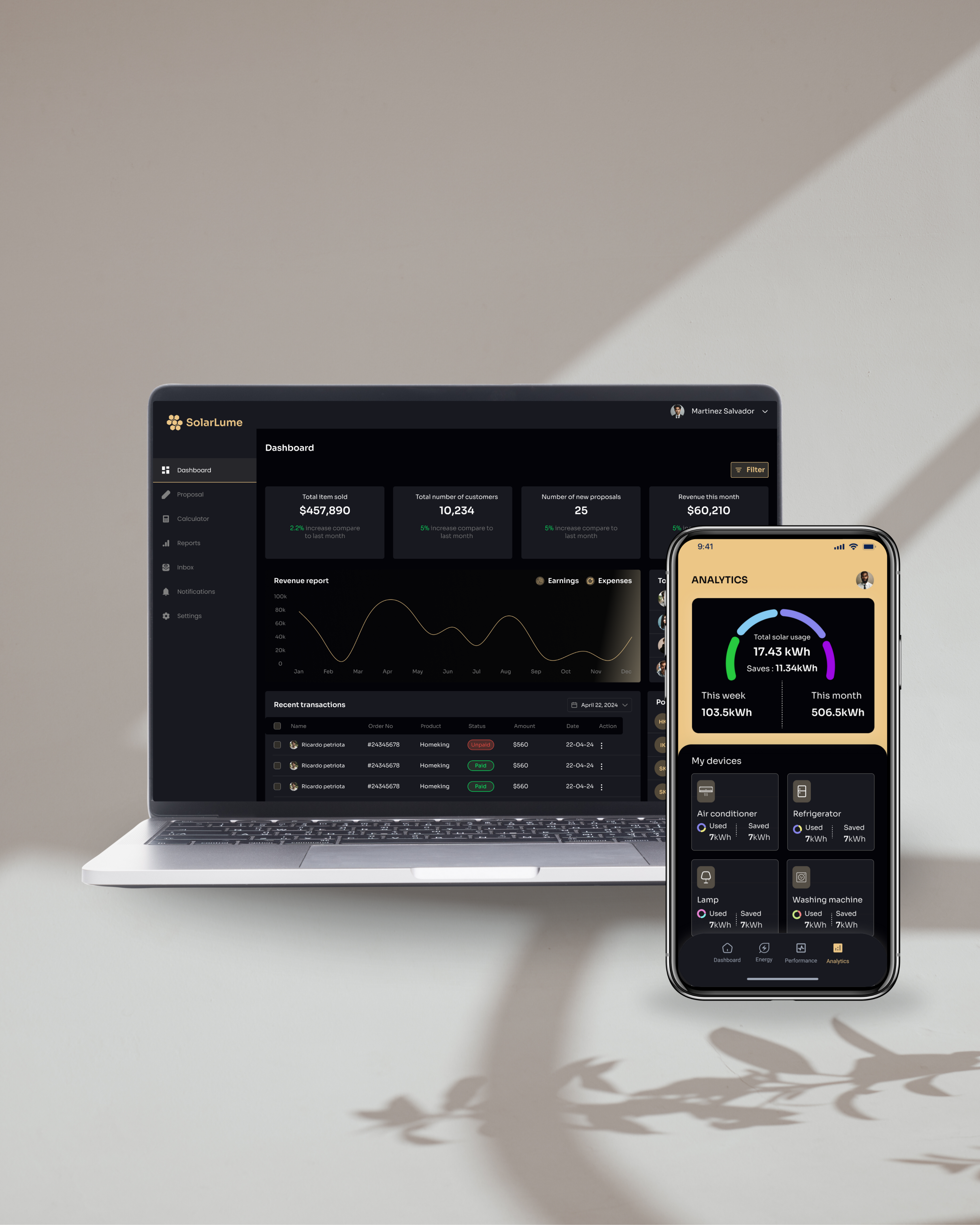
Solarlume: web and mobile app design
Solarlume web app and mobile app design.
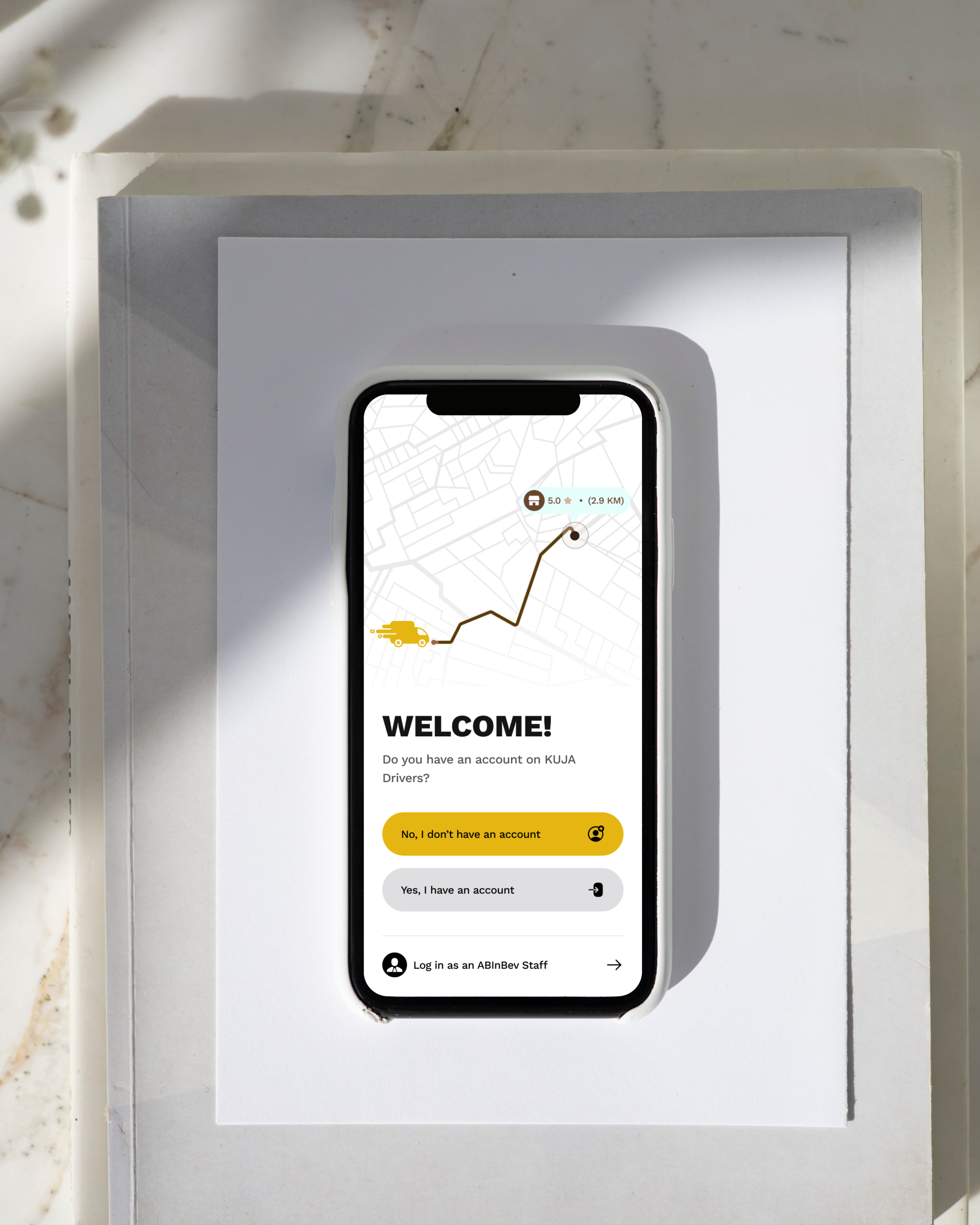
Kuja Drivers: mobile app for products delivery
Kuja Drivers mobile app design.
harles
Copyright 2025 by Charles Nwafor